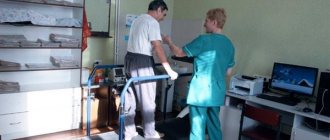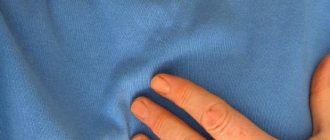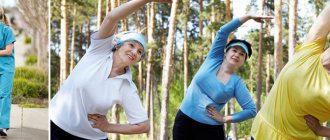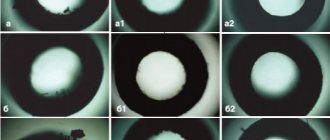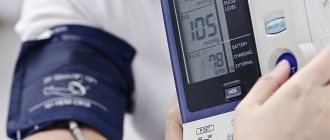Heart disease is always associated with a threat to the patient’s life; special techniques are being developed for their treatment and complete rehabilitation. Each patient needs an individual approach; specific methods can be adjusted taking into account objective changes in the condition. During a myocardial infarction, the heart muscle dies completely or partially due to insufficient blood supply; in most cases, coronary atherosclerosis leads to such consequences.
Stationary stage
At this stage, it is not so much the physical recovery of the patient that is important, but the moral one. He must believe that not everything is lost, that a healthy lifestyle can be completely restored, that the disease has receded for a long time and there is no need to be afraid of relapses. But the desired result can be achieved only under one condition - the patient himself will make every effort and unconditionally follow all medical recommendations.
During the stationary stage of physical rehabilitation, the sick person must fully take care of himself and take walks of two to three kilometers. In addition, exercise therapy efforts should ensure:
- localization and elimination of complications that arise after prolonged bed rest. Consequences of outpatient treatment may include intestinal disturbances (atony), thromboembolism, and congestive pneumonia. Restoring movement makes it possible to restart the vital functions of the body;
- the maximum possible restoration of the performance of the cardiovascular system at the initial stage, training of peripheral circulation. In this case, the load on the heart is selected as sparingly as possible, the patient is constantly monitored;
- orthostatic stability, restoration of simple motor functions.
As soon as the patient is convinced of the progress of the results of the fight against the disease, he will have positive emotions and confidence in his future. Normalization of mental state also plays a very important role in the process of returning to a normal lifestyle.
Contraindications for exercise therapy
Physical therapy, as well as some other methods of auxiliary therapy, should be carried out after a thorough examination of the patient. Classes are contraindicated in the following cases:
- temperature rise;
- fever;
- pain of any nature in the heart;
- difficulty breathing, wheezing;
- pulmonary edema;
- circulatory failure;
- deterioration of ECG parameters;
- cardiogenic shock.
If there is a disturbance in heart rhythm even when taking medications, exercise therapy is not performed. However, the patient can carry out light actions on his own: move his toes, hands, bend them at the knee, elbow. There is so-called finger gymnastics, which the sick person performs without the risk of developing complications.
Is it possible to return to normal life after a heart attack?
The duration and quality of rehabilitation depends on the influence of many factors, primarily the severity of the heart attack.
Concomitant pathologies and complications, age and occupation, etc. play a role. During rehabilitation (and not only) a diet should be followed, the risks of stressful situations should be minimized, a healthy lifestyle should be maintained, preventative medications and medical supervision should be performed. The list and nature of measures is selected for each patient and should be applied in combination.
Indications and contraindications for exercises
Exercise therapy is indicated for all patients with myocardial infarction whose condition has stabilized and is not life-threatening. In this case, physical activity will have a restorative effect and be of great benefit to the patient.
Absolute contraindications:
- left ventricular aneurysm;
- frequent attacks of angina pectoris;
- FP;
- polytopic, group, frequent ECS;
- PT;
- Hypertension with diastolic AT > 110 mmHg;
- tendency to thromboembolic complications.
Physical activity
After illness, physical activity should increase gradually; forcing events often causes very serious complications. After several days after the acute period, the patient can slowly (on his own or with the help of others) get out of bed, holding the supports with his hands. The first steps can be taken only after transfer to a regular ward. You can only walk on a flat surface and avoid shortness of breath or feelings of fatigue. The duration and distance of walking increases gradually.
In a hospital, a doctor must supervise exercise therapy classes. The same exercises can be performed at home after leaving the hospital. In this case, you should constantly remember to monitor the condition. One of the important indicators of a successful rehabilitation course is pulse and blood pressure. After normal physical exercise, the frequency of contraction of the heart muscle should not exceed 100–120 beats per minute.
Classification of severity of condition
Myocardial infarction occurs when a blood clot or atherosclerotic plaque blocks the lumen of a coronary vessel. Persons suffering from atherosclerosis and chronic coronary insufficiency are at increased risk.
Characteristic symptoms of a heart attack are acute, sharp pain, significant deterioration in general condition: suffocation, weakness, fever, drowsiness. Pain sensations are localized in the heart area and can radiate to the epigastric region or between the shoulder blades.
According to WHO, there are four functional classes of severity of the condition of patients who have suffered a myocardial infarction:
- I – pain appears only during heavy physical exertion. The usual ones - walking, climbing stairs - do not cause discomfort.
- II – pain occurs during walking, climbing stairs, emotional stress, after waking up. The patient's movements are somewhat limited.
- III – pain appears even when walking on level ground for short distances (200-400 m), while climbing stairs to one floor. Motor activity is noticeably limited.
- IV – pain occurs even with the slightest load, the patient is unable to perform normal work. This class includes patients with severe complications of the post-infarction state: angina pectoris, heart failure, cardiac arrhythmia, conduction disturbances, infectious or non-infectious endocarditis.
Treatment of myocardial infarction is complex. Along with medications, therapeutic massage and gymnastics are prescribed.
Physiotherapeutic procedures
They are considered an important addition to physical rehabilitation methods and significantly speed up the process of restoring important vital signs. Most often it is recommended to do self-massage and breathing exercises. If the course of rehabilitation is favorable, gradual exercise with measured loads and time is allowed. These types include ordinary walking over longer distances, race walking, swimming, and cycling.
Exercise therapy technique for rehabilitation
Rehabilitation activities are divided into 3 stages. Exercise therapy after a heart attack is selected taking into account the severity class of the patient’s post-infarction condition.
Stage I – hospital
Treatment and recovery of the patient is carried out in a hospital until clinical recovery begins (acute symptoms of the disease have subsided, but the condition is dangerous for relapse and complications).
- Reduce the risk of possible complications. Due to weakened heart muscle, limited mobility, and blood clotting disorders, the likelihood of developing thromboembolism, congestive pneumonia, intestinal atony, and muscle weakness increases.
- Improve the functioning of the cardiovascular system with light physical exercise. The loads are intended to stabilize peripheral blood circulation and vascular tone.
- Adapt the patient to everyday stress, restore simple motor skills.
- Improve psycho-emotional state.
With a mild heart attack, therapeutic exercises begin 3-4 days after the acute signs of the disease disappear. The basic form of exercise therapy has 4 stages of physical activity:
- The patient must remain in bed. However, you can begin minimal physical activity. Perform complex of therapeutic exercises No. 1 1 time/day. Breathing is not recorded, this can cause heart pain. If the condition remains stable, the patient begins to sit down for 5-10 minutes 3 times a day. The first sitting down takes place under the guidance of a nurse or exercise therapy instructor.
- After 3-5 days of successful sitting down, therapeutic exercises are repeated 1.5-2 hours after lunch. Duration 10-15 minutes. Be sure to measure your pulse and blood pressure before and after exercise. If there are no complications, move on to the next step.
- The patient also continues to perform set of exercises No. 1. You are allowed to get out of bed. Walk first around her, then around the ward, eat while sitting at the table.
- The patient is prescribed gymnastics complex No. 2. The first 2-3 classes are conducted under the supervision of an instructor. It is allowed to walk around the ward, the corridor, and climb several steps up the stairs. The number of exercises and walking distance are increased gradually.
If, with an increase in physical activity, shortness of breath, pain, or fatigue appears, the exercises are stopped or the load is reduced, and additional breathing exercises by Strelnikova or Buteyko are introduced.
Complex of therapeutic exercises No. 1 (performed in a lying position):
- bending the feet towards oneself, away from oneself;
- flexion-extension of fingers;
- raise your arms, lightly reach towards your knees, do not raise your head;
- bend each leg in turn, without lifting the foot from the bed;
- bend your legs at the knees, lower them to the right, then to the left;
- bend your legs at the knees, reach with your right hand to your left knee, do the same with the other hand;
- simultaneously move your right arm and left leg to the side, turn your head to the right, take the starting position, repeat with the other arm and leg;
- clench your fists, rotate your hands, simultaneously with your feet;
- arms straight, squeeze your buttocks together, straining your leg muscles, relax.
When performing physical therapy for the first time, each exercise is done 1 time, gradually increasing the load, bringing it up to 8 times.
Complex of therapeutic exercises No. 2 (performed while sitting on a chair):
- lean against the back of a chair, raise your arms to your shoulders, spread your elbows to the sides, lower them;
- clench and unclench your fists while simultaneously rolling your feet from heels to toes;
- slide your feet back and forth across the floor without lifting your feet off the floor;
- spread your straight arms to the sides, then put them on your knees, slightly tilt your torso forward, straighten up;
- holding the seat of the chair with your hands, raise your right shoulder up, lower your left shoulder down, then do the opposite;
- with your hands, pull your left knee to your chest, repeat the same with the right;
- hands on the belt, pull your elbows and shoulders forward, tilt your head down; straighten your elbows, shoulders, bend your back, turn your head first to the right, then to the left.
When performing physical therapy for the first time, each exercise is done 1 time, gradually increased to 8 times.
Stage II – post-hospital
Readaptation after a heart attack is carried out in a rehabilitation center, sanatorium, or clinic. The recovery period begins after discharge from the hospital. Lasts about two months, with an uncomplicated form of the disease.
The purpose of exercise therapy for myocardial infarction:
- restore the patient’s performance, eliminate insufficient motor activity, remove restrictions on the range of movements;
- gradually increase physical activity in order to prepare the recovering person for everyday and professional work conditions.
Therapeutic exercises are not performed if the patient continues to have circulatory failure, cardiac arrhythmia, or an aortic or cardiac aneurysm is detected.
Basic forms of exercise therapy:
- dosed, slow walking, first 500-900 m, then 2-3 km with rest;
- climbing stairs to 2-3 floors;
- cardio exercises: exercise bike or treadmill (only with an instructor) 1 time/week;
- gymnastics: perform complex exercises No. 1, No. 2, increase the load by adding new elements. The total duration of classes is 20-30 minutes.
Stage III – supporting
It begins 4 months after a heart attack and continues throughout life. If therapeutic exercises were performed daily during readaptation, at this stage performance approaches the same as in healthy people.
- increasing and maintaining normal physical performance;
- prevention of coronary heart disease, recurrent heart attack;
- complete social and everyday adaptation;
- reducing the number of medications taken.
Gymnastics classes are similar for people with poor health and low mobility. Recommended:
- exercises at the gymnastic wall;
- therapeutic exercises with light dumbbells;
- long walks every day;
- climbing the stairs to the 5th floor;
- training on simulators 2-3 times/week.
In the first year after a heart attack, the risk of another attack is highest. Therefore, a person recovering should regularly monitor their condition. You need to measure your blood pressure daily, monitor your pulse, breathing, and heartbeat during activity. Physical therapy exercises should be easy, without overexertion.
Exercise therapy occupies a leading place in the rehabilitation of post-infarction patients. The main task is a gradual increase in loads, adaptation to social and work life, complexity, and management of each patient during the first stage of recovery.
Nutrition
Depending on the period of illness, three different diets are recommended.
- The first week after an acute attack. When preparing food, salt is completely excluded; you can only steam or boil it; you are prohibited from eating fried foods. To facilitate the work of the intestines, food is pureed, the number of meals is increased to seven times a day, and the size of portions is reduced. You are allowed to drink up to 800 ml of liquid.
- Second and third week. Still, salt is not used and fried foods are prohibited. There is no need to wipe, just finely chop. The number of receptions is reduced to 5, and the size of portions increases slightly. The amount of liquid you drink increases to a liter.
- Fourth week (period of myocardial scarring). When cooking, salt is not used; dishes are steamed or boiled. The number of meals is reduced to four, and the portions increase. It is allowed to take large pieces of food, the volume of liquid drunk increases to 1.1 liters. If the doctor considers it possible, then a little (up to 4 g) table salt is allowed.
A set of exercises after a heart attack
The exercise therapy complex after myocardial infarction or measures taken to eliminate and prevent it is divided into 7-8 stages, the first 4 are carried out in the hospital. The simplest exercises are included, which must be performed in strict sequence. Their complexity increases with each stage.
Stage 1
Physical education begins 2-3 days after a diagnosed myocardial infarction. The duration of the lesson does not exceed 10 minutes per day. Most of the exercise therapy takes place on the patient's bed, he performs it lying down. The doctor helps the patient perform fairly simple exercises:
- bend your fingers and toes;
- rotational movements of the hands and feet;
- relaxation and tension of muscles in parts of the body alternately;
- sitting up in bed with the support of medical staff and medical devices.
Breathing exercises are also important: the patient inhales and exhales slowly, and does not hold his breath for long.
After each exercise, the sick person should rest. The rest time is approximately the same as that used to perform the action. Each exercise is performed slowly.
After physical education, the patient’s condition is diagnosed. The following indications are considered satisfactory:
- heart rate increases by 20 positions or decreases by 10;
- breathing rate is 10 cycles higher;
- increase in pressure up to 30 mm Hg.
If the criteria differ, exercise therapy is stopped and postponed for several days.
If the patient responds well to physical exercise, the actions become more complicated:
- alternately bend the fingers;
- rotate with hand, elbow;
- bend your arms at the elbows, bend your legs at the knees;
- rotate their head, tilt it.
After 3-4 days of positive dynamics, they move on to the second, more complex stage of restorative physical education.
Stage 2
The second stage of exercise therapy includes the previous exercises, but they are done more often, for example 3 times a day. Then, after 2-3 days, the following is added to the previous actions:
- large amplitude of rotation in the elbow, shoulder, knee and hip joints;
- sitting up on the bed independently (using special devices);
- sitting on the edge of the bed, legs down.
From the previous position, the person tries to rest his feet on the floor and then stand up. After a few days he can walk 2-3 steps next to the bed. The patient is allowed to sit at the table when eating.
Relapse Prevention
The work of the heart muscle depends on the psycho-emotional state and physical activity. Both factors can have both positive and negative effects on the patient's condition. Some suspicious patients think that the appearance of any pain in the heart area indicates an imminent return of the disease, causing them confusion, fear of death and anxiety.
Panic can last for several months from the moment the first pain appears, but over time everything is forgotten and returns to its usual routine. To eliminate fear, it is recommended to contact your doctor or psychologist; it is strictly forbidden to overload the nervous system for a long time. The patient must learn to independently manage emotions correctly and prevent stressful situations from arising. Depending on individual characteristics, the total duration of rehabilitation can reach three months or more.
After a myocardial infarction, the patient is prohibited from drinking all alcoholic beverages without exception, and he is not allowed to smoke. Refusal prevents the recurrence of cardiac pathology, and failure to follow a healthy lifestyle significantly increases the risks to life.
Treatment of obesity is one of the mandatory conditions for rehabilitation after a heart attack.
The benefits and goals of exercise therapy after a heart attack
The term exercise therapy (therapeutic physical education) refers to the regular implementation of rehabilitation programs. They include exercises with subsequent complication. Physical education is used as an auxiliary therapy in eliminating the consequences of myocardial infarction and preventing complications after pathology.
A well-designed set of exercises after a heart attack and stenting will help solve a number of problems. The goals of physical education are to prevent the development of diseases:
- heart and respiratory failure;
- thrombosis;
- arrhythmias;
- intestinal atony;
- narrowing of the lumen of arteries and veins;
- spasm of blood vessels;
- metabolic disorders;
- poor blood supply to the heart muscle and other organs;
- pathological reaction of the adrenal glands to hormonal drugs.
During productive exercise therapy, myocardial microcirculation and peripheral blood supply to the extremities are restored.
The main goal of conducting physical exercises for patients in the cardiology department is to prevent recurrent myocardial infarction and other pathologies of the cardiovascular system. Physical education helps not only to lose excess weight, strengthen the nervous system and psyche, but also to almost completely restore a person.
The patient, following the instructions of the cardiologist and rehabilitation specialist, quickly returns to the usual rhythm of life, the ability to self-care and professional stress.
Rehabilitation after coronary stenting
The use of coronary stenting during the treatment of heart diseases began to be used relatively recently. The problematic area of the artery is expanded using a wire frame (stent), which expands the vessel to physiological sizes.
During the operation, the chest is not opened, which greatly facilitates the patient’s rehabilitation process and reduces the total time spent in a medical facility.
Ways and methods of rehabilitation
After surgery, you can use the same rehabilitation techniques as for other methods of treating coronary artery disease.
Physiotherapy
Physical education comes first. But the load and types of exercises are adjusted depending on the course of the disease and the speed of recovery of the body. Due to the fact that damage to the heart muscle has not reached irreversible effects, therapeutic exercises can be performed with increased loads.
Most patients are recommended to engage in a health path - strictly dosed in terms of inclination, distance and time, walking in the fresh air along specially selected routes.
In gyms you can exercise on so-called cardio equipment - bicycles and treadmills. The intensity, duration and tempo are selected individually, the loads increase gradually. The patient is obliged to monitor his well-being, before starting classes and immediately after their completion, check his pulse and blood pressure.
Physical activity plays a complex positive role, it trains muscles, improves emotional state and helps to reduce excess weight. In addition, the blood supply and performance of all the patient’s organs are normalized. There are no special sets of exercises, but everyone is recommended to adhere to several general rules.
- Do exercises daily. To do this, it is not necessary to visit gyms; it is enough to do gymnastics at home, jogging or walking in the fresh air.
- Do not force the intensity of the loads. A set of exercises should not make you feel very tired.
- You should exercise not only during rehabilitation, but also after it.
If discomfort occurs or blood pressure rises excessively, then you need to reduce the duration and intensity of exercise.
Psychological rehabilitation
A very important link in the complex of prescribed measures. Constant fear of recurrence of the disease can cause a persistent state of stress. And this has an extremely negative impact on the functioning of the cardiovascular system, increasing risk factors for coronary artery disease, heart attacks and strokes. A professional specialist will help you cope with unreasonable worries and teach you how to manage your emotions. Another important point is that loved ones and relatives should treat the patient with understanding and attention and minimize the number of stressful situations caused by family circumstances.
Diet
Proper nutrition should simultaneously perform several tasks: help stabilize weight within optimal parameters, ensure the body is fully nourished, and prevent an increase in cholesterol levels in the blood. In this case, special attention should be paid to reducing the amount of products that cause a narrowing of the lumen of blood vessels.
Traditionally, foods that cause increased cholesterol formation are excluded; you should not abuse strong coffee and tea.
It is necessary to increase the consumption of vegetables and fruits in any form, make meals smaller.
Sanatorium-resort rehabilitation
A very effective method, the patient is under constant medical supervision. It is possible to accurately adjust the exercises and prescribe, if problems are detected, special supportive drug treatment. Some patients are recommended to take medications to prevent blood clots.
For the walls of blood vessels, the stent is a foreign body, the body tries to block it. Clots form in the blood, which can stick to the stent and break off over time under the influence of increased physical activity or stressful situations. The period of continuous use of medications can be up to a year. Changes in postoperative support methods are made only on the basis of clinical and laboratory test data. Read about watery acne on our website.
Diet and nutrition
After stenting is performed, rehabilitation should be gradual in compliance with all instructions of the attending physician. One of the main criteria for successful recovery is maintaining a proper diet.
Stenting relieves the consequences of coronary artery disease, but does not eliminate the cause. The main factor in the development of the disease is elevated cholesterol levels in the blood. Therefore, a balanced diet and its regimen are aimed at minimizing these indicators. Additionally, the diet helps to get rid of excess weight and thereby reduces the load on the heart.
The main principles of the diet are as follows:
- it is necessary to completely exclude animal fats from the diet and limit vegetable fats;
- It is recommended to eat food with a minimum amount of salt, no more than five grams per day;
- You should also protect your body from mayonnaise, margarine and other complex fats;
- You should completely avoid drinking strong drinks (tea, coffee) and soda;
- alcohol is also prohibited in any quantity;
- it is recommended to enrich the diet with fresh fruits, vegetables and berries;
- It is advisable to cook dishes by steaming or in the oven; fried foods should be completely avoided;
- It is not recommended to eat at night; you should take your last meal 3 hours before going to bed.
The optimal amount of calories per day is 2300 Cal (the female norm is slightly lower, no more than 2000). However, it is important to follow a diet, dividing the total number of calories into 4-7 small meals . Products also need to be selected carefully. The diet must be composed of:
- berries, vegetables and fruits;
- plenty of fresh herbs;
- fermented milk products;
- lean fish (required);
- seafood;
- poultry meat with the addition of vegetable oil, preferably olive;
- lean meats;
- cereal crops.
How long rehabilitation after stenting will last depends entirely on the patient’s compliance with all medical instructions. However, a competent physical therapy program and a balanced diet provide certain guarantees for a speedy recovery.

